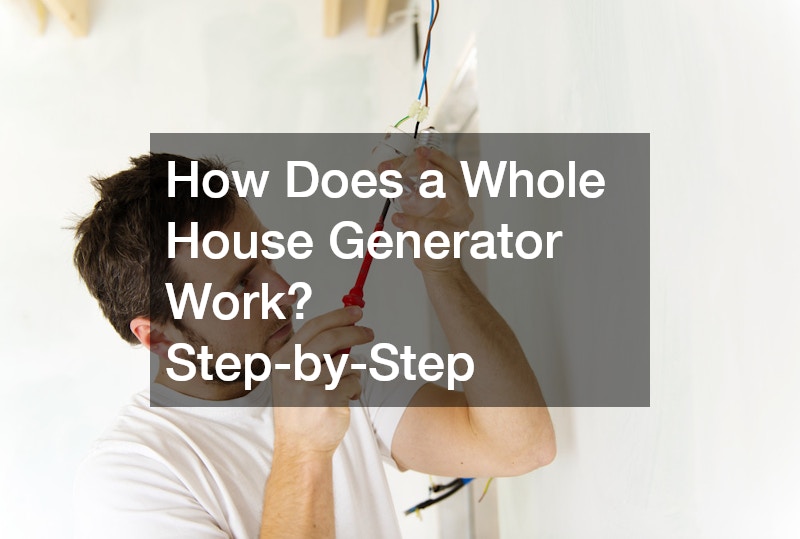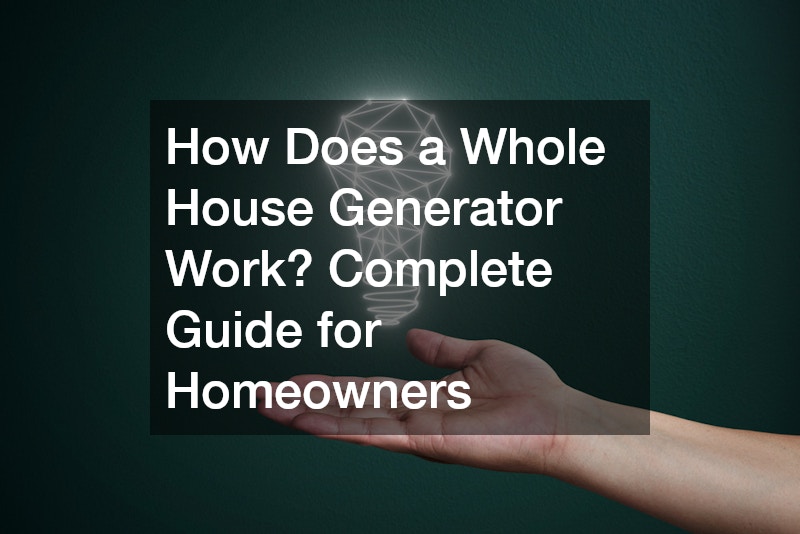Power outages can be frustrating and disruptive, especially when they last for several hours or even days. Fortunately, a whole house generator can keep your home running smoothly during an outage by providing backup power. But how exactly does a whole house generator work? In this guide, we’ll break down the components, operation process, and benefits of these systems so you can better understand how they keep your home powered during emergencies.
What is a Whole House Generator?
A whole house generator, also known as a standby generator, is a backup power system that automatically provides electricity to your entire home during a power outage. Unlike portable generators, which need to be manually operated and can only power a few appliances, a whole house generator is permanently installed and wired directly into your home’s electrical system.
Whole house generators are typically powered by natural gas, propane, or diesel, and they are designed to activate automatically when a power interruption is detected.
Key Components of a Whole House Generator
To understand how a whole house generator works, it’s essential to know the key components that make up the system. Each of these elements plays a crucial role in ensuring continuous power supply during an outage.
1. Generator Engine
The engine is the heart of the whole house generator. It provides the mechanical energy needed to generate electricity. Most whole-house generators are powered by natural gas, propane, or diesel engines. The fuel type you choose will depend on availability, cost, and your personal preferences.
- Natural Gas: Often connected to a home’s existing gas line, allowing for an uninterrupted fuel supply.
- Propane: Stored in tanks and requires refueling but offers more flexibility in areas without gas lines.
- Diesel: Commonly used in large generators, providing long runtimes but requiring regular refueling.
2. Alternator
The alternator is responsible for converting mechanical energy from the engine into electrical energy. This process is crucial because it generates the electricity that powers your home’s appliances and systems. The alternator contains a rotor and stator, which work together to create a magnetic field and produce electric current.
3. Transfer Switch
One of the most important components of a whole house generator is the automatic transfer switch (ATS). The transfer switch monitors the power coming from your local utility company. When an outage occurs, the ATS detects the loss of power and automatically switches your home’s electrical system from the utility grid to the generator. Once power is restored, the ATS switches your home back to the utility grid and turns off the generator.
Without the transfer switch, you would need to manually connect the generator to your home’s electrical panel during an outage, which can be time-consuming and unsafe.
4. Control Panel
The control panel is the generator’s brain, managing its operation. It includes features like automatic start and stop, monitoring of electrical load, and system diagnostics. Some advanced models even offer remote monitoring, allowing homeowners to check the generator’s status from a smartphone or computer.
5. Fuel System
The fuel system supplies the generator with the fuel it needs to run. Depending on the type of generator, this may involve a connection to a natural gas line, a propane tank, or a diesel fuel tank. The fuel system also includes fuel filters, lines, and pumps to ensure that the engine receives a steady supply of fuel.
6. Cooling and Exhaust System
Like any engine, the generator’s engine produces heat while operating. The cooling system helps regulate the engine temperature to prevent overheating. Whole house generators typically use air or liquid cooling systems. In addition, the exhaust system channels gases, such as carbon monoxide, safely away from the engine and the home.
7. Lubrication System
A whole house generator’s engine has many moving parts that require lubrication to prevent wear and tear. The lubrication system ensures that engine components remain properly oiled, reducing friction and extending the life of the engine.
8. Battery
A battery powers the electric starter for the generator engine. This battery ensures that the generator can start automatically as soon as a power outage is detected. It also provides power to the control panel during generator operation.
How Does a Whole House Generator Work? Step-by-Step

Now that you’re familiar with the key components let’s walk through the step-by-step process of how a whole-house generator operates during a power outage.
1. Monitoring Utility Power
The automatic transfer switch continuously monitors the electrical power coming from your utility company. As long as power is flowing normally, the generator remains in standby mode, ready to spring into action if needed.
2. Detecting a Power Outage
When a power outage occurs, the transfer switch detects the interruption in the utility grid. This detection is instantaneous, often happening in a matter of seconds. The transfer switch signals the control panel to activate the generator.
3. Starting the Generator
Once the outage is detected, the generator’s control panel automatically starts the engine using the battery-powered electric starter. The engine begins to run, generating mechanical energy.
4. Switching to Generator Power
After the generator is up and running, the automatic transfer switch disconnects your home from the utility grid and connects it to the generator’s electrical output. This switch is seamless, meaning you’ll only experience a brief interruption before your power is restored.
5. Powering the Home
With the generator now running and the transfer switch engaged, your home is supplied with electricity from the generator. The alternator converts the mechanical energy from the engine into electrical power, which flows through your home’s electrical panel to keep appliances, lights, and systems functioning normally.
6. Monitoring the Power Load
Throughout this process, the generator’s control panel monitors the electrical load to ensure that it is not overworked. If the generator begins to approach its maximum capacity, the control panel may limit the amount of electricity supplied to non-essential systems to prevent overloading.
7. Returning to Utility Power
Once power is restored by your local utility company, the transfer switch detects the return of electricity. The system then automatically switches your home back to the utility grid, and the generator shuts off. The whole process requires no manual intervention and is typically seamless, ensuring minimal disruption.
What Happens During Extended Outages?
A well-maintained whole house generator can run for extended periods, as long as there is a steady fuel supply. However, periodic maintenance is essential during long outages to ensure the generator continues to operate efficiently.
1. Fuel Management
If your generator runs on propane or diesel, you’ll need to monitor fuel levels and arrange for refueling during extended outages. Natural gas generators can run for longer periods without the need to refuel, as long as the gas supply is uninterrupted.
2. Routine Maintenance
It’s important to perform regular maintenance during extended use. This includes checking the oil levels, coolant levels, and air filters. Most manufacturers recommend shutting the generator down for brief maintenance every 24-48 hours of continuous operation.
Benefits of a Whole House Generator
Having a whole house generator provides several advantages, especially in areas prone to frequent power outages.
1. Automatic Operation
The automatic start feature ensures your home is powered within seconds of an outage, without the need for manual intervention.
2. Continuous Power Supply
A whole house generator can power your entire home, including HVAC systems, refrigerators, water heaters, and security systems. This helps keep your family safe and comfortable during extended outages.
3. Protection from Power Surges
When the generator automatically engages, it prevents power surges that could potentially damage sensitive electronics.
4. Peace of Mind
Whether you’re home or away, you can rest assured knowing that your home will remain powered during an outage. Some generators even offer remote monitoring, allowing you to check on the system from anywhere.
Conclusion
A whole house generator is a powerful backup solution that automatically provides electricity during a power outage. By understanding how these systems work, from fuel supply to automatic transfer switches, you can appreciate the value and reliability that a whole house generator brings to your home. With proper maintenance, your generator will keep your home running smoothly during any power interruption, offering peace of mind and safety for your household.
